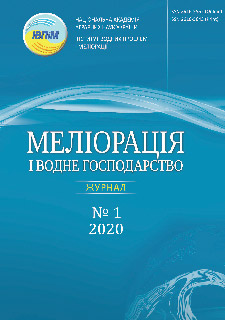Soil pest control for maize when applying drip and sprinkler irrigation
Abstract
In Ukraine, the application of pesticides along with irrigation water (pestigation) is becoming more widespread and popular. The use of insecticides when applying them along with irrigation water on reclamation systems (insecticide method) is a reliable way to reduce the number of dangerous pests. The advantage of this method is the possibility of timely delivery of plant protection products to crops during their critical periods, and rapid application of pesticides regardless of weather conditions.
The use of insecticides along with drip irrigation to control owlet moth caterpillars was carried out in the II-III decades of June. The most effective products were: Woliam Flexi 300 SC, Ampligo 150 ZC FC and Enzhio, 247, SC. Among the one-component products reliable protection of crop plants was provided by Actara, 240 SC. Under drip irrigation, owlet moth larvae control proved was rather effective, reaching 85,7-100%. On the variant with the maximum rate of insecticides, the highest efficiency was provided by the preps of Woliam Flexi 300 SC, Ampligo 150 ZC and Enzhio, 247 SC (97,1-100%).
Against the larvae of Agriotes the reliable protection of corn when applying insecticides along with drip irrigation, was obtained on the variant with Voliam Flexi 300 SC, KS, where having an application rate of 0,3 l/ha, the protection level was 97,1%.
Reduction in the number of owlet moth caterpillars and Agriotes arvae on the variants of the experiment provided crop density and enabled to obtain a higher yield of corn grain. When applying Woliam Flexi 300 SC, Ampligo 150 ZC and Enzhio, 247 SC, at the maximum application rates, the crop density averaged 84-88 thou /ha. In general, on the variants of the experiment when the maximum rates of multi-agent preps were applied, the maize productivity was 2,0-2,4 t/ha. higher than the figures on the reference variants.
References
2. Olgarenko, I. V. (2009). Raczionalizacziya rezhima orosheniya v usloviyakh izmenchivosti gidrometeoparametrov (na primere kormovoj svekly`) [Rationalization of the irrigation regime under conditions of variability of hydrometeoparameters (for example, fodder beets)]. Melioracziya i vodnoe khozyajstvo, 1, 36-38. [in Russian].
3. Shhedrin, V.N., & Kuly`gin, V.A. (2011). Osobennosti vodopotrebleniya ovoshhny`kh kul`tur po periodam vegetaczii pri oroshenii [Features of water consumption of vegetable crops during the growing season during irrigation]. Melioracziya i vodnoe khozyajstvo, 2, 28-31. [in Russian].
4. Balabukh, V.O., Matytska, L.V., Lavrynenko, O.V., Baliuk, S.A., & Solovei, V.B. (2018). Adaptatsiia ahrotekhnolohii do zmin klimatu: gruntovo-ahrokhimichni aspekty [Adaptation of agricultural technology to winter climate: environmental and agricultural aspects]. Baliuk, S. A., Medvedev, V. V., & Noska, B. S. (Ed.). Kharkiv: Stylna typohrafiia. [in Ukrainian].
5. Voloshin, O.S., Liman, P.B., & Dudar, A.I. (1986). Produktivnaya vlaga pod ozimoj psheniczej v intensivny`kh sevooborotakh Severnoj Stepi Ukrainy [Productive moisture under winter wheat in intensive crop rotation of the Northern Steppe of Ukraine]. Stepnoe zemledelie: Resp. mezhved. temat. nauch. sb., vol.20, 9-13. [in Russian].
6. Shatkovskyi, A. (2018). Vyroshchuvannia kukurudzy na kraplynnomu zroshenni [Growing of corn on drip irrigation]. Ahronom. Retrieved from: https://www.agronom.com.ua/vyroshhuvannya-kukurudzy-na-kraplynnomu-zroshenni/ [in Ukrainian].
7. Ghidiu, G., Kuhar, T., Palumbo, J., & Schuster, D. (2012). Drip Chemigation of Insecticides as a Pest Management Tool in Vegetable Production. Journal of Integrated Pest Management, Volume 3, Issue 3, E1–E5. Retrieved from: https://doi.org/10.1603/IPM10022
8. Trybelia, S.O. (Ed.). (2001). Metodyky vyprobuvannia i zastosuvannia pestytsydiv. Kyiv: Svit. [in Ukrainian].
9. Shatkovskij, A.P., Mel`nichuk, F.S., & Semenko, L.O. (2013). Osnovnye aspekty vneseniya fungiczidov s polivnoj vodoj na sistemakh kapel`nogo orosheniya plodovykh nasazhdenij [The main aspects of the application of fungicides with irrigation water on drip irrigation systems of fruit stands]. Puti povy`sheniya e`ffektivnosti oroshaemogo zemledeliya, Vol. 50, 171–175. [In Russian].
10. Ghidiu, G. M., & Smith, N. L. (1980). Trickle irrigation system injected insecticides to control the European corn borer in bell pepper. Results of pest control studies, Rutgers University Cooperative Extension Service Publication Report 1, 5– 6.
11. Kerns, D. L., & J. C. Palumbo. (1995). Using Admire on desert vegetable crops. IPM Series No. 5, University of Arizona Cooperative Extension Publication No. 195017.
12. Felsot, A. S., W.Cone, J. Yu, & Ruppert, J. R. (1998). Distribution of imidacloprid in soil following subsurface drip chemigation. Bulletin of Environmental Contamination and Toxicology, 60, 363–370.
13. Kuhar, T. P., Schultz, P., Doughty, H., Wimer, A., Wallingford, A., Andrews, H., Philips, C., Cassell, M., & Jenrette, J. (2011). Evaluation of foliar insecticides for the control of green peach aphids in broccoli in Virginia. Arthropod Management Tests, 36: E4. doi: 10.4182/amt.2011.E4.


